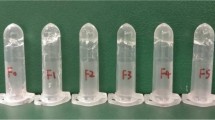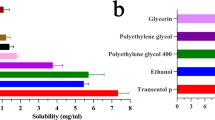Abstract
This study developed a new transdermal delivery system for the improved delivery of sinomenine hydrochloride (SH). The delivery system utilized the advantages of lyotropic liquid crystals (LLC) creating an adaptable system that offers a variety of options for the field of transdermal delivery. The formulation was prepared, characterized, and evaluated for its skin penetration in vitro. In the study, the appearance of samples was characterized by visual observation, and these LLC gels were colorless and transparent. Polarizing light microscopy (PLM) and small-angle X-ray diffraction (SAXS) were used to analyze the internal structures of gels, and the gels displayed a cubic double-diamond (Pn3m) internal structure with a dark field of vision. The Franze diffusion cell was used to evaluate its skin penetration. There were several factors which might influence the skin penetration of drugs, such as drug loading, water content, and the layer spacing of the LLC. In our case, drug concentration gradient played a more powerful role. The result of in vitro permeation studies demonstrated that the drug concentration was higher; the cumulative osmotic quantity of SH (Q) was greater. Therefore, the system was a promising formulation for successful percutaneous delivery of SH through the skin.





Similar content being viewed by others
References
Li X, Li P, Liu C, et al. Sinomenine hydrochloride inhibits breast cancer metastasis by attenuating inflammation-related epithelial-mesenchymal transition and cancer stemness. Oncotarget. 2017;8(8):13560–74.
Sun Y, Yao Y, Ding CZ. A combination of sinomenine and methotrexate reduces joint damage of collagen induced arthritis in rats by modulating osteoclast-related cytokines. Int Immunopharmacol. 2014;18:135–41.
Qian L, Xu Z, Zhang W, et al. Sinomenine, a natural dextrorotatory morphinan analog, is anti-inflammatory and neuroprotective through inhibition of microglial NADPH oxidase. J Neuroinflammation. 2007;4(1):1–14.
Zhao Y, Li J, Yu K, et al. Sinomenine inhibits maturation of monocyte-derived dendritic cells through blocking activation of NF-kappa B. Int Immunopharmacol. 2007;7(5):637–45.
Gao T, Hao J, Wiesenfeld-Hallin Z, et al. Analgesic effect of sinomenine in rodents after inflammation and nerve injury. Eur J Pharmacol. 2013;721:5–11.
Zhou H, Wong YF, Wang J, Cai X, Liu L. Sinomenine ameliorates arthritis via MMPs,TIMPs, and cytokines in rats. Biochem Biophys Res Commun. 2008;376:352–7.
Zhang MF, Zhao Y, Jiang KY, et al. Comparative pharmacokinetics study of sinomenine in rats after oral administration of sinomenine monomer and Sinomenium acutum extract. Molecules. 2014;19(8):12065–77.
Li L, Buchet R, Wu Y. Sinomenine, theophylline, cysteine, and levamisole: Comparisons of their kinetic effects on mineral formation induced by matrix vesicles. J Inorg Biochem. 2010;104:446–54.
Zhao Z, Xiao J, Wang J, et al. Anti-inflammatory effects of novel sinomenine derivatives. Int Immunopharmacol. 2015;29(2):354–60.
Wu X, Chen Y, Gui S, et al. Sinomenine hydrochloride-loaded dissolving microneedles enhanced its absorption in rabbits. Pharm Dev Technol. 2015;21(7):787–93.
Teng P, Liu HL, Zhang L, et al. Synthesis and biological evaluation of novel sinomenine derivatives as anti-inflammatory agents. Eur J Med Chem. 2012;50:63–74.
Long H, Liu Y, Chen D, et al. Evolution and prospect of Zheng Qingfeng Tong Ning injection. Central South Pharm. 2012;10(4):303–6.
Li X, Li X, Zhou Y, et al. Development of patch and spray formulations for enhancing topical delivery of sinomenine hydrochloride. J Pharmaceut Sci. 2010;99(4):1790–9.
Langer R. Transdermal drug delivery: past progress, current status, and future prospects. Adv Drug Deliv Rev. 2004;56(5):557–8.
Thomas BJ, Finnin BC. The transdermal revolution. Drug Discov Today. 2004;9(16):697.
Kadhum WR, Sekiguchi S, Hijikuro I, et al. A novel chemical enhancer approach for transdermal drug delivery with C17-monoglycerol ester liquid crystal-forming lipid. J Oleo Sci. 2017;66(5):443.
Yariv D, Efrat R, Libster D, et al. In vitro permeation of diclofenac salts from lyotropic liquid crystalline systems. Colloids Surf B Biointerfaces. 2010;78(2):185–92.
Mishraki T, Libster D, Aserin A, et al. Temperature-dependent behavior of lysozyme within the reverse hexagonal mesophases (H(II)). Colloids Surf B Biointerfaces. 2010;75(2):391.
Kim DH, Jahn A, Cho SJ, et al. Lyotropic liquid crystal systems in drug delivery: a review. J Pharmaceut Investig. 2015;45(1):1–11.
Hitesh J, Rushikesh G, Gauri J, Jagruti M, Nirali T. Liquid crystal as accelerant in drug absorption from topical formulations. Int Res J Pharm. 2011;2(4):86–9.
Sekhon BS. Surfactants: pharmaceutical and medicinal aspects. J Pharm Technol Res Manag. 2013;1:11–36.
Guo C, Wang J, Cao F, Lee RJ, Zhai G. Lyotropic liquid crystal systems in drug delivery. Drug Discov Today. 2010;15(23–24):1032–40.
Rajabalaya R, Musa MN, Kifli N, et al. Oral and transdermal drug delivery systems: role of lipid-based lyotropic liquid crystals. Drug Des Dev Ther. 2017;11:393.
Chen Y, Xin L, Ping M, et al. Phytantriol-Based In Situ Liquid Crystals with Long-Term Release for Intra-articular Administration. Aaps Pharmscitech. 2015;16(4):846–54.
Liu Q, Wan XX, Huang XP. A study on the relationship between the octanol/water partition coefficient and transdermal speed constant of sinomenine. J Branch Campus First Mil Med Univ. 2000;23(1):5–6.
Wang B, Wang YQ, Yi-Qiong PU, et al. Apparent Oil/water Partition Coefficient of 20(S)-PPD and Its Intestinal Absorption in Rats. Chin J Inf Tradit Chin Med. 2011;18(12):59–61.
Kaiser KLE, Valdmanis I. Apparent octanol/water partition coefficients of pentachlorophenol as. Can J Chem. 2011;60(16):2104–6.
Mcbride EM, Kretsch A, Garibay LK, et al. Rapid experimental and computational determination of phenethylamine drug analogue lipophilicity. Forensic Chem. 2016;1:58–65.
Carvalho FC, Campos ML, Peccinini RG, et al. Nasal administration of liquid crystal precursor mucoadhesive vehicle as an alternative antiretroviral therapy. Eur J Pharm Biopharmaceut. 2013;84(1):219.
Borgheti-Cardoso LN, Depieri LV, Diniz H, Calzzani RA, Fantini MC, Lyomasa MM, et al. Self-assembling gelling formulation based on a crystalline-phase liquid as a non-viral vector for siRNA delivery. Eur J Pharm Sci. 2014;58(16):72–82.
Han K, Pan X, Chen M, Wang R, Xu Y, Feng M, et al. Phytantriol-based inverted type bicontinuous cubic phase for vascular embolization and drug sustained release. Eur J Pharm Sci. 2010;41(5):692–9.
Akbar S. Phytantriol based smart nano-carriers for drug delivery applications. Eur J Pharmaceut Sci. 2017;101:31–42.
Suksaeree J, Nawathong N, Anakkawee R, et al. Formulation of Polyherbal Patches Based on Polyvinyl Alcohol and Hydroxypropylmethyl Cellulose: Characterization and In Vitro Evaluation. Aaps Pharmscitech. 2017:1–10.
Souza C, de Freitas LA, Maia Campos PM. Topical Formulation Containing Beeswax-Based Nanoparticles Improved In Vivo Skin Barrier Function. Aaps Pharmscitech. 2017:1–12.
And CR, Kunieda H. Effect of Electrolytes on Discontinuous Cubic Phases. Langmuir. 2000;16(22):8263–9.
Rodriguez-Abreu C, Acharya DP, Aramaki K, et al. Structure and rheology of direct and reverse liquid-crystal phases in a block copolymer/water/oil system. Colloids Surf A Physicochem Eng Asp. 2005;269(1):59–66.
Sato T, Hossain MK, Acharya DP, et al. Phase Behavior and Self-Organized Structures in Water/Poly(oxyethylene) Cholesteryl Ether Systems. J Phys Chem B. 2004;108(34):12927–39.
Cohenavrahami M, Aserin A, Garti N. H(II) mesophase and peptide cell-penetrating enhancers for improved transdermal delivery of sodium diclofenac. Colloids Surf B Biointerfaces. 2010;77(2):131–8.
Sintov AC, Botner S. Transdermal drug delivery using microemulsion and aqueous systems: influence of skin storage conditions on the in vitro permeability of diclofenac from aqueous vehicle systems. Int J Pharm. 2006;311(2):55–62.
Guyot M, Fawaz F. Design and in vitro evaluation of adhesive matrix for transdermal delivery of propranolol. Int J Pharm. 2000;204(1–2):171–82.
Barauskas J, Landh T. Phase behavior of the phytantriol/water system. Langmuir. 2003;19(23):9562–5.
Costa P, Lobo JMS. Modeling and comparison of dissolution profiles. Eur J Pharm Sci. 2001;13(2):123–33.
Réeff J, Gaignaux A, Goole J, et al. Characterization and optimization of GMO-based gels with long term release for intraarticular administration. Int J Pharm. 2013;451(1–2):95–103.
Chaiyana W, Rades T, Okonogi S. Characterization and in vitro permeation study of microemulsions and liquid crystalline systems containing the anticholinesterase alkaloidal extract from Tabernaemontana divaricata. Int J Pharm. 2013;452(1–2):201–10.
Efrat R, Aserin A, Garti N. On structural transitions in a discontinuous micellar cubic phase loaded with sodium diclofenac. J Colloid Interf Sci. 2008;321(1):166–76.
Iwanaga T, Kunieda H. Effect of added salts or polyols on the cloud point and the liquid-crystalline structures of polyoxyethylene-modified silicone. J Colloid Interface Sci. 2000;227(2):349.
Patil SS, Venugopal E, Bhat S, Mahadik KR, Paradkar AR. Mapping ion-induced mesophasic transformation in lyotropic in situ gelling system and its correlation with pharmaceutical performance. Pharm Res. 2013;30(7):1906–14.
Phan S, Fong WK, Kirby N, Hanley T, Boyd BJ. Evaluating the link between self-assembled mesophase structure and drug release. Int J Pharm. 2011;421(1):176–82.
Patil SS, Venugopal E, Bhat S, Mahadik KR, Paradkar AR. Exploring microstructural changes in structural analogues of ibuprofen-hosted in situ gelling system and its influence on pharmaceutical performance. AAPS PharmSciTech. 2015;16(5):1153–9.
Cao JJ, Li ZG, Li Q, et al. Preparation and evaluation of sinomenine liquid crystal gel. Chin Pharm J. 2017;52(19):1691–7.
Misiūnas A, Niaura G, Barauskas J, et al. Horse heart cytochrome centrapped into the hydrated liquid-crystalline phases of phytantriol: X-ray diffraction and Raman spectroscopic characterization. J Colloid Interface Sci. 2012;378(1):232–40.
Nuki G, Ferguson J. Studies on the nature and significance of macromolecular complexes in the rheology of synovial fluid from normal and diseased human joints. Rheologica Acta. 1971;10(1):8–14.
Ghosh I, Michniak-Kohn B. A comparative study of vitamin E TPGS/HPMC supersaturated system and other solubilizer/polymer combinations to enhance the permeability of a poorly soluble drug through the skin. Drug Dev Ind Pharm. 2012;38(11):1408.
Latsch S, Selzer T, Fink L, et al. Crystallisation of estradiol containing TDDS determined by isothermal microcalorimetry, X-ray diffraction, and optical microscopy. Eur J Pharm Biopharm. 2003;56(1):43–52.
Éder André E, Fabíola Silva Garcia P, Ana Beatriz C, Maria Bernadete Riemma P, Marilisa Guimarães L. Liquid crystalline systems for transdermal delivery of Celecoxib: in vitro drug release and skin permeation studies. Am Assoc Pharm Sci. 2014;15(6):1468–75.
Clogston J, Rathman J, Tomasko D, Walker H, Caffrey M. Phase behavior of a monoacylglycerol (Myverol 18-99K)/water system. Chem Phys Lipids. 2000;107:191–220.
Acknowledgements
The content is solely the responsibility of the authors and does not necessarily represent the official views of China Pharmaceutical University.
Funding
The authors are grateful for financial support from the National Natural Science Foundations of China (No. 81274099, No. 81072537), the Anhui Provincial Natural Science Foundation (No. 1408085QH183), Key University natural science research project of Anhui province (KJ2018A0301), and the Exploratory Research Projects of Anhui University of Chinese Medicine (No. 2016ts066).
Author information
Authors and Affiliations
Corresponding author
Ethics declarations
Conflict of Interest
The authors declare that there is no conflict of interest.
Rights and permissions
About this article
Cite this article
Chu, X., Li, Q., Gui, S. et al. Characterization and In Vitro Permeation Study of Cubic Liquid Crystal Containing Sinomenine Hydrochloride. AAPS PharmSciTech 19, 2237–2246 (2018). https://doi.org/10.1208/s12249-018-1018-z
Received:
Accepted:
Published:
Issue Date:
DOI: https://doi.org/10.1208/s12249-018-1018-z




